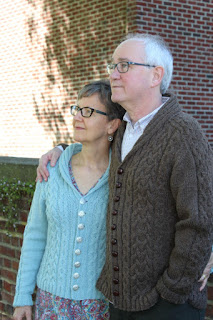Glentrekker Cardigan: Staying in Pattern at the Raglan Line
Welcome to the next post in a series about knitting the
The previous one was about joining the sleeves and body,
so what comes next?
Working the raglan decreases while keeping all those cables intact, that's what!
Before we look specifically at some of the cables in the Glentrekker and how to navigate the decreases with those, let's look at the ordinary
2/2 RC worked at a rate of every four rows when confronted with a raglan line.
The vertical diagonal white line at the left is the right-leaning raglan line worked as k2tog (knit two together), k1 (knit one) at a rate of every four rows. The k2tog decrease worked this way forms a stacked, clean line all the way to the neckline. On the facing raglan line, the left-leaning decrease is worked as k1, ssk (slip one knitwise, slip one knitwise, knit the two slipped stitches together) every four rows, which forms a clean line all the way up to the neckline as well. Point A shows the last full 2/2 RC (two/two right cross, a four-stitch back cross) to be worked without involving the k2tog decrease. After that, no more cable crosses have been attempted.
This is all a matter of personal preference, but I do not like for my raglan lines to look like this. I like to make those cables cross just as close to that raglan line as possible. I want it to appear as if the cable pattern goes on about its business in the background, with the raglan line hovering over what appears to be a fully-completed cable fabric going on uninterrupted underneath. Sometimes I can accomplish that and sometimes I only come close, but I can certainly do better than that poor 2/2 RC abandoned to become a plain, old band of knit stitches.
How to do that? Let's examine this more closely.
Point B on the left-leaning raglan line to the right is the same complete 2/2 RC as in point A. Moving up four more rows, we see that point C is a partial cable from the three stitches left after a raglan decrease, a 2/1 RC. Point D shows that when the raglan line had eaten the cable stitches down to only two, I worked a 1/1 RC. Shortly after, at point E, the raglan line had obliterated the remaining cable stitches.
But how did I work the partial cables while at the same time working the raglan decreases?
Point F is a good example, and there we see that both the raglan lines are about to devour that middle 2/2 RC. At this point I knit one stitch, slipped one stitch, re-positioned the four stitches to be worked as a 2/2 RC (two to the back and two to the front, with the front two being worked first). I completed the ssk with the stitch I first slipped and the first stitch of the newly-re-positioned cable stitches. Once the cable stitches were in position, I worked across the next two stitches and then k2tog with the last of them and the first of the raglan line. After that, it was all over with and the raglan line had gobbled up everything.
So, if you find yourself in the predicament of having a raglan decrease come in conflict with a cable cross, try this. For the left leaning decrease, slip the first of the ssk decrease, re-position the cable as you normally would do, and then work the ssk with the first of the stitches intended for the cable. Do the same for the right-leaning decrease, except re-position the cable stitches first, knit to the last stitch of the cable, and then knit two stitches together with it and the raglan line stitch. All of this business is done on the right side of the fabric so you can see exactly what you're doing, I might add.
This will work with any sort of cable, with varying results.
Be brave and try it!
 |
| Bare Naked Wools Kent DK |
This is a closeup of the right front decrease line eating up a 2/2 RC on the Glentrekker and the converging body raglan line eating up another at a rate of decreasing every right-side row. At point G you see a 2/1 RC cable, the decrease taking away the first of its stitches, the next RS row ate another stitch, and at point H, the decrease line finished off the last of them. Since a left-leaning raglan line depletes a 2/2 RC cable differently than a right-leaning one does, you see in point J that a 1/2 RC keeps the semblance of right-cross action before the next decrease takes away another stitch and then finally at point K, the last stitch of the cable is gobbled up.
I could go on and on, because there are a few different cables in the Glentrekker, However, as I told you in this post, there are a whole lot of 2/2 RC cables in this sweater, so this all will take you far when trying to stay in pattern while decreasing the upper body of the cardigan.
The main thing to do is to trust yourself and work these as you see fit, as you think best. There are many ways to do this, and I'm sure you will discover your own favorites!


Comments